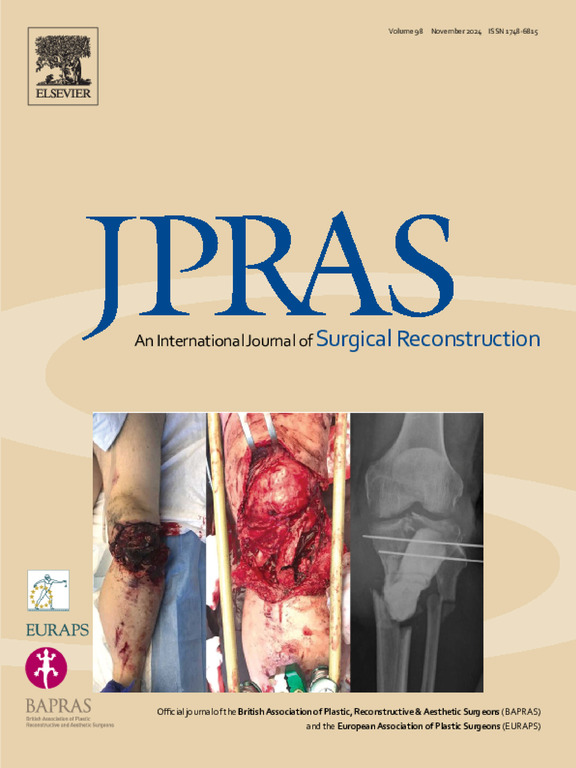人类脱细胞神经同种异体移植在上肢连续性神经瘤手术治疗中的挑战。
IF 2
3区 医学
Q2 SURGERY
Journal of Plastic Reconstructive and Aesthetic Surgery
Pub Date : 2025-02-01
DOI:10.1016/j.bjps.2024.11.050
引用次数: 0
摘要
损伤后神经功能的恢复可能会因出现无组织纤维团块(神经瘤)而变得复杂。这会导致感觉和/或运动缺陷和疼痛,这可能会严重削弱。手术切除疼痛的神经瘤可能会留下一个间隙,可以用自体移植物或同种异体移植物来填补。本研究的主要目的是获得上肢神经病变后连续使用脱细胞异体移植物切除和重建疼痛性神经瘤患者1年的临床结果。在一项前瞻性队列研究中,我们评估了21名连续患者。评估患者的疼痛、运动和手部感觉功能以及患者报告的结果。结果显示,术后1年,47%(≥S3)的患者感觉恢复,48%的患者持续不耐冷,48%的患者致残性超敏反应,25%的患者在同种异体移植物近端或内形成新的神经瘤。Q-DASH显示52%的患者结果不佳。总体而言,43%的患者在休息和活动时持续疼痛。测量肌肉力量显示,握力是未受伤手的60%,握力是未受伤手的58%,这在统计学上是显著的。即使切除了神经瘤,用人类脱细胞神经异体移植物进行连续性和重建,有限的功能结果、疼痛、冷耐受和感觉亢进可能持续存在于治疗患者中。在同种异体移植物的近端或内部也存在新神经瘤形成的风险。本文章由计算机程序翻译,如有差异,请以英文原文为准。
Challenges in the surgical treatment of neuroma in continuity in the upper extremity using human acellular nerve allografts
The restoration of nerve function after the injury might be complicated by the development of a disorganized fibrous mass—a neuroma. This results in sensory and/or motor deficits and pain that can be severely debilitating. Surgical excision of the painful neuroma may leave a gap, which can be bridged using autografts or allografts. The main objectives of this study were to obtain 1-year clinical results in patients who underwent excision and reconstruction of a painful neuroma in continuity using decellularized allografts after nerve lesions in the upper extremity.
In a prospective cohort study, we evaluated 21 consecutive patients. The patients were evaluated for pain, motor, and sensory function of the hand as well as with patient-reported outcomes.
The results showed meaningful sensory recovery in 47% (≥S3), persisting cold intolerance in 48%, disabling hypersensitivity in 48%, and new neuroma formation proximal to or within the allograft in 25% of patients, one year post-operatively. Q-DASH showed 52% of patients with poor results. Overall, 43% of the patients had persisting pain in rest and activity. Measuring muscle strength showed grip strength of 60% and a pinch of 58% of the strength measured in the uninjured hand, which was statistically significant.
Even with the excision of a neuroma in continuity and reconstruction with human acellular nerve allograft, limited functional outcome, pain, cold intolerance, and hyperesthesia may persist in the treated patients. There is also the risk of new neuroma formation proximal to or within the allograft.
求助全文
通过发布文献求助,成功后即可免费获取论文全文。
去求助
来源期刊
CiteScore
3.10
自引率
11.10%
发文量
578
审稿时长
3.5 months
期刊介绍:
JPRAS An International Journal of Surgical Reconstruction is one of the world''s leading international journals, covering all the reconstructive and aesthetic aspects of plastic surgery.
The journal presents the latest surgical procedures with audit and outcome studies of new and established techniques in plastic surgery including: cleft lip and palate and other heads and neck surgery, hand surgery, lower limb trauma, burns, skin cancer, breast surgery and aesthetic surgery.

 求助内容:
求助内容: 应助结果提醒方式:
应助结果提醒方式:


